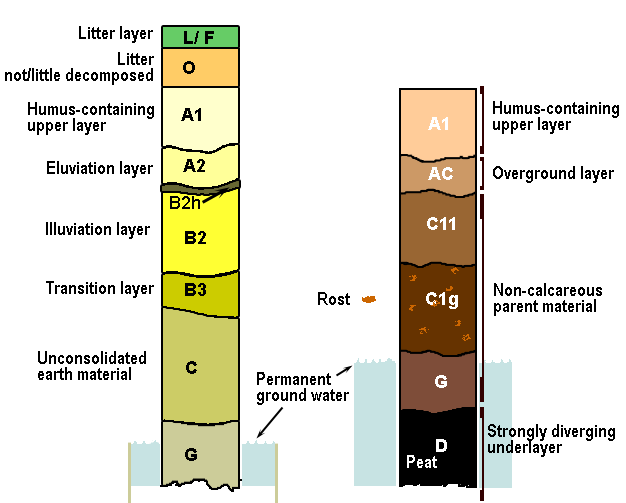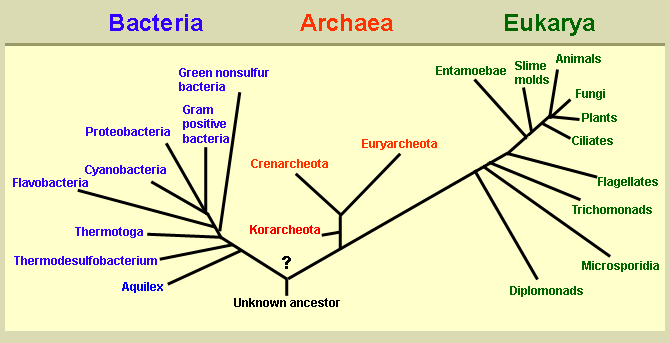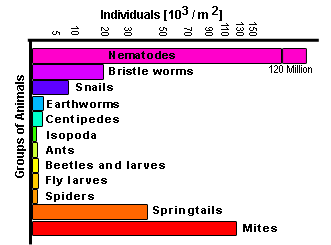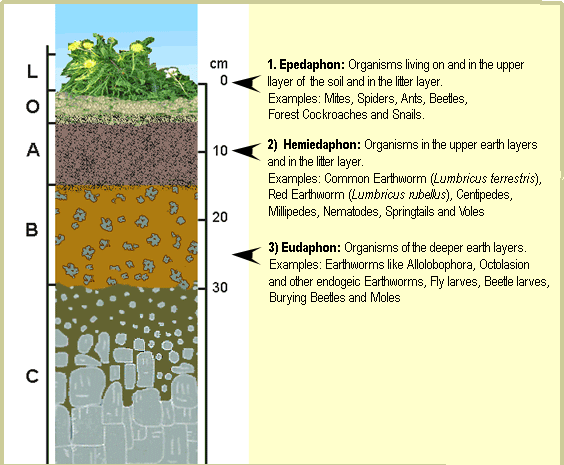What is a soil?
The term Soil indicates approximately the upper layer of the ground in which the life of plants, animals and man takes place. This surface layer is distinct form the rocks or sediments in the deeper layers, since its composition is subject to changes under influence of physical, chemical, biological and anthropogenic factors. These changes results in the formation of vertical layering: so-called soil profiles and soil horizons (zone of soil profile that can be discriminated due to its color and other morphological characteristics from other zones).
Three phases can be distinguished in a soil:
- free phase (minerals and organic material, among which living organisms)
- liquid phase (water and the therein dissolved nutrients)
- gasous phase (e.g. oxygen of importance for the respiration of roots)
.
| Soil profile and names of horizons |
 |
Hypothetical soil profiles with example of codes for horizons.
L (or F): Litter (Förna = litter)
0: Litter layer of not or little decomposed plant material
A: Eluviation layer, divided into:
A1: Upper layer, dark in color, very rich in humus
A2: Mineral layer relatively poor in clay material, iron, aluminium or all three due to leaching
B: Illuviation horizon, divided into:
B1: Gradual transition layer from A2 to B2
B2: Layer with maximal illuviation
B3: Gradual transition from B2 to a C-horizon.
C: Unconsolidated earth material. Not or only little weathered material
g: g indicates the layers where iron, sedimented under anaerobe conditions, became oxidized later to ironoxide or rost
G: G indicates the permanent non-aerate or poorly aerate parts of the soil, characterized by the blue-gray color of ironsulfide (FeS = pyrite). These layers are mostly in the deeper part of the profile. |
How does a soil develop?
Soil development regards the complex interactions between earth material (bedrock, rocks, clay, sand), the topography (= the location of certain elements in the landscape), the climate and living organimsms. Roughly speaking two types of soils can be diistinguished:
1) Organic soil determined by accumulation ofmaterial in swamps of peat and
2) Mineral soils arisen from weathering of rocks (minerals). In these webpages we will only focus on the second type.
- 2a.Chemical weathering
When chemical weathering happens the rock dissolves or changes in chemical composition of the rock occurs under influence of organisms or substances: Any bedrock or exposed rock will be colonized by algae, lichens or mosses. The population of those organims expands when water is present. Under dry conditions the organisms can become dormant (quiescent), so that they can survive the unfavorable drought period. They take up light enenrgy to produce organic matter (they are autotrophic) which on its turn stimulates the growth of chemo-organotrophic organisms (organisms which are partly or completely dependant of organic compounds), like bacteria and fungi. The increase in amount of chemo-organotrophic organisms is proportional to the amount of plant growth.
Carbon dioxide that is produced by the respiration of chemo-organotrophic organisms, is transformed by the soil to bicarbonate and protons according to:
CO2 + H2O ↔H2CO3 ↔ HCO3- + H+
These protons (H+) play an important role in dissolving the rock, especially limestone. Many of the above-mentioned organisms also produce organic acids. Acidification results in fragmentation of solid rock or sediments.
- 2b. Mechanical weathering
When mechanical weathering takes place the rock crumbles off under influence of weather and climate: Cracks in hard rocks increase in number and size due to freezing of water, leading to expansion and application of pressure, alternated with thawing of ice. In these cracks bit by bit a raw soil is formed, in which pioneer plants can survive. Plant roots further penetrate in these cracks, and enhance on their turn the fragmentation process. Secretion products have a favorableeffect on the development of the microflora and microfauna in the rhizosphere (the space around the roots). When plants die away their remains are added to the already present soil particles. When nutrients are liberated from these remains they boost the microbiological development. Organic matter is further demineralized and when water passes it drains some of the components to deeper layers. When weathering processes are sustained the soil layer become bigger, so that larger weeds and trees can grow.
Which organisms are present in the soil?
An important factor for soil development is the increase in the number of species and individuals of soil animals. By roots and fauna activity the top layer is mixed and aired. In some types of soil a soil profile (see figure) is formed due to relocation of minerals and organic material. The velocity of development of such profile is determined by climatiological and other local conditions, but one can estimate it to a period of at least 100 years.
Main groups of microorganisms in the soil
The soil is a habitat for microorganisms which florish in certain parts. Extensive increase of microbial activity can be found at the surface of soil particles, mainly in the rhizosphere. A small aggregate of soil particles with for example a size of about 0.1-0.2 mm, can provide space for a large number of different micro-environments (presence of minerals ororganic material, aerobe, anaerobe, dry, wet) so that diverse types of micro-organisms can live best.
| Tree of Life |
 |
| Trees of Life, adapted to the presence of organims in the soil (according to Brock, Biology of Microorganisms) |
Flavobacteria as well as Cyanobacteria occur in and on soils, Cyanobacteria (in past also called blue algae) on a humid soil surface where they can form mats. They are aerobe photo-autotrophic organisms. Tot the Proteobacteria belong the nitrificating bacteria like Nitrosomonas, furtheron methanotrophic bacteria that oxidize methane. Under the Grampositive bacteria a large group of soil-living species are encountered, including the genera Bacillus and Clostridium, species involved in the aerobe (oxidation) and anerobe (reduction) breakdown and mineralization of nutrients from organic material. From the Archaea only the Subphyla are inidcated. The Crenarchaeota have been discovered in oceans a.o. as nitrifiers (ammonium → nitritet); recently it has become evident that they are also of importance in soil systems and that they are in fact very abundant there. To the Euryarchaeota belong the methanogenic organisms that perform the final step of methane formation. The group of Protozoae can be very large in the soil, they cover the groups Entamoebes, Ciliates and Flagellates. Their function is mainly that of detritivores, bacterivores and decomposition.
Fauna (Animals) in the soil
Beside the earlier-mentioned Protozoae also Eukaryotes can be found in the soil, but Rotifers and Water bears (Tardigrades) are only of secondary interest. See figure below on the proportion of organims in an ideal soil and in various layers.
 |
| Density in numbers of animal groups in an European grassland soil (measured in number per square meter until a depth of 30 cm in the soil; adapted according to estimations by McFadyen, 1962) |
The Roundworms (=
Nematodes) are very abundant, often, but not always, as parasites, of plants, and sometimes of other animals, for example on larves of flies. Among the Ringworms (=
Annelids), the Bristle Worms (=
Polychaetes) and the Olygochaetae classified as White Worms (= Enchytraeidae) and Earthworms (=
Lumbricidae), form an important group among soil organimsms, which comprises the endemic geni Dendrobaena, Lumbricus (species
L. terrestris, Grote regenworm, and
L. rubellus, Rode regenworm), Allolobophora and Octolasion. Within the subphylum of the
Crustaceae, belonging to the large phylum of the
Arthropodae, are well represented the
Isopodae) and the
Arachnidae, among which the true
Araneae), the
Mites (subclass of the
Acarinae) and the Oribatid Mites (=
Oribatida). Other noteworthy inhabitants of the soil are the Centipedes (=
Chilopodae) and moreover the Millipedes (=
Diplopoda). Of course the large number of insects living in the soil (=
Insectae) should not be forgotten. Among them are important for the soil-biology the Springtails (
Collembolae) and the larves of Flies and Mosquitoes(=
Dipterae), larval and adult stages of Beetles (=
Coleopterae), as well as
Ants and/or
Termites, especially in the tropics. Furtheron comprised to the soil-biology Bare the Snails (=
Gastropodae) belonging to the Mollusca. Vertebrates that live partly or entirely underground are of another order, e.g.
Mole,
Rabbit and other Rodents (
Voles,
Hamster).
Life communities and interactions in the soil
Interactions between plant roots, fauna and microorganisms belowground have a direct effect on the condition of the soil.
| Life communities and soil |
 | Links is een verdeling in horizonten aangegeven zoals verklaard hierboven. Het voorbeeld betreft een eutrofe, middeneuropesche bosleemgrond onder een Beukenbos op basaltlava (Burgenland, Oostenrijk). |
- One of the primary functions of soil organisms is to contribute to the recycling of nutrients that are present in the litter layer. In first instance the process of decomposition is enhanced by small evertebrates (Springtails, Centipedes, Isopodes, beetles and fly larves, earth worms and others) which reduce the littlematerial into smaller portions. Besides, microbes (bacteria, protozoa, fungi) are important for degrading macomolecules enzymatically to anorganic compounds, which in turn can be taken up by plants. Both the temperature and the humidity level in the soil affect the ground organisms and the velocity of decomposition.
- The understanding of interaction processes between species (and diversity) of above-ground and below-ground organisms has great blanks, in particular because of our limited knowledge on soil organims; less than than 10% of all soil bacteria and nematode species are wel-known. At a large scale, correlations can be depicted, but at a smaller scale relationships appear to be much more variable and less predictable.
- Characteristical for interactions among soil organisms, in contrast to above-ground communities, are inter-dependent relationships (mutualistic relations). The majority of dominant plant species of an ecosystem has symbiotic relations with microorganisms living in the soil. Mycorrhizzae (symbiotic communities between plant roots and certain soil fungi) are an clear example of this phenomenon: the fungi help the root to absorb mineral products by greatly increasing the uptake surface. Thus, the status of nutrient uptake of the plant (e.g. a tree) is much improved. Micorrhizae fungi are furtheron able to reach and transfer "resources" that would not be directly accessible for the plant (plant detritus, that is non-living particulate organic material, and organic material, unsolved mineral compound like phosphate). The fungi contributetothe protection of roots against pathogens, among others by producing antibiotics, by competing with other, noxious fungi and by stimulating the formation of strong chemically-resistant cell wall in the plant. As a 'reward' mycorrhizzae fungi receive carbohydrate compounds from their host, the plant.
In other words, plant species that are encountered at the earth surface are in fact dependent from underground-living species in order to develop and function well. The precision of the interdependency seems to indicate that species can not be randomly exchanged, even not within the same functional group.
Sources
- Madigan MT & Martinko JM (2006) Brock, Biology of Microorganisms. 11en edition. Pearson Education International.
Christian Leveque & Jean-Claude Mounolou (2004). Biodiversity. John Wiley & Sons Ltd, Chichester (England).
- Werner Topp (1981). Biologie der Bodenorganismen. Quelle und Meyer, Heidelberg (BRD).
- Robert Leo Smith (1986). Elements of Ecology. 2d edition. Harper & Row, Publishers, New York.
- Scheffer & Schachtschabel (1984). Lehrbuch der Bodenkunde. Ferdinant Enke Verlag, Stuttgart.
- Kubiena WL (1950) Bestimmungsbuch und Systematik der Böden Europas.
- World Soil information en museum
- Gaiabodem: met o.a.:"Ontdek de bodem!"







